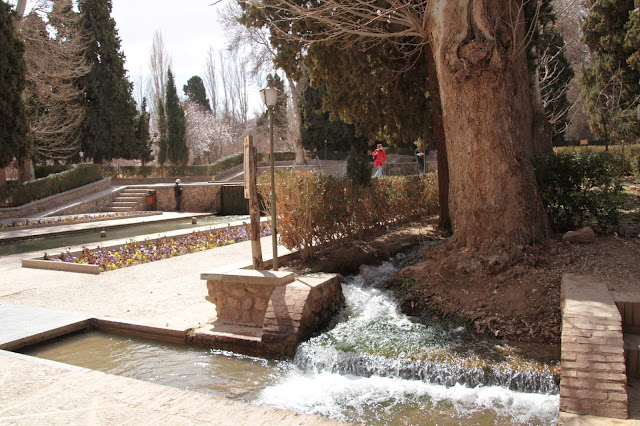We are up terribly early. Breakfast was limited to those who arrived first. The rest of us had to tough it out on a sip of black coffee and some corn flakes in milk. The lucky ones, who still enjoy sweets, were offered a cake. Tehran this early is completely empty. At the daybreak we had arrived at what used to be an international airport nowadays used for mostly internal flights. Before entering usual security check. Only this time we were strictly segregated by sex. Security check was not very thorough, so I was able to keep my water bottle. I also didn’t have to show my computer. Check-in was Iranian style. We all dropped our luggage together and then our Iranian lady guide distributed boarding tickets. Tehran awarded us smog free morning, with a beautiful sight of Elbruz. Many of our travelling companions had tried to take pictures of this beautiful mountain causing loud and angry protests of airport personnel. The airplane was quite comfortable and the flight uneventful. The service was much better then on our own Adria Airways. All luggage had arrived safely. In short – BRAVO – very professional.
Letališče Kerman zapustimo prijetno presenečeni, brez rentgenske kontrole. Z avtobusom, ki bo naš do konca potovanja, se zapeljemo mimo hotela do vrtov Shazdeh . Shazdeh pomeni Prinčevski. Nastali so v 19 stoletje med vladavino dinastije Qajar. Gradili so jih okoli 1850. Vrtovi so zasnovani okoli dveh umetnih potočkov in osrednjih teras z bazeni, ki so žal bili prazni in umazani. Verjetno smo prezgodaj. Le nekatera drevesa so pričela sramežljivo cveteti. Ideja sama vrt v puščavi je zanimiva. Še vedno jo izkoriščajo, gradijo namreč podaljšek. Od vhoda se vrt počasi vzpenja. Na vrhu je skupina stavb, v kateri je slabo prepoznavna kapelica (vsaj nam neposvečenim) in trgovinica z zanimivimi spominki. Na levo je neka vrsta čajnice ali kadilnice, kjer se obiskovalci sproščajo.We had left Kerman airport pleasantly surprised- no X ray security check. With the bus, which will be ours for the duration of the journey, we had been driven by the hotel towards Shazdeh garden. Shazdeh garden means Prince’s garden. It was built in 19th century, around 1850, during the rule of Qujar dynasty. Gardens are based around two streams and central terraces with the large pools, which were unfortunately dirty and empty. Oh well, I suppose we were too early in the year for gardens to be presentable. Just few shy blooming trees were around. The idea itself, the gardens in the desert is fascinating. It is still exploited because they were building an extension. From the entrance the garden is sloping up. At the top there is a group of buildings, in which the chapel or prayer room is located, together with the small souvenir shop full of interesting souvenirs. To the left there is kind of tea house, where people relax smoking water pipes.
V samem mestu Mahan obiščemo grobnico sufijskega pesnika Shah Nematollah Vali. Impresivni minareti in kupola. V notranjosti nad grobom prozoren sarkofag poln denarja. Shah Nematollah Vali je živel v 14. In 15. Stoletju, natančneje od 1330–1431. Potoval in poučeval je po Perziji in Indiji. Če vas zanima njegova poezija http://erfan-onabadi.com/Selected_Articles/poems_from_Shah_Nematollah_Val/body_poems_from_shah_nematollah_val.html). Žal nam je misel na poezijo pregnalo dejstvo, da nas je vse malo zeblo in da smo bili že pošteno lačni. Ko smo se končno obuli se opravimo v mesto iskati hrano. Vendar trgovci v Mahanu niso bili pripravljeni na trumo turistov, ki so na nerazumljuvem jeziku zahtevali čudne stvari. Na koncu nam ob pomoči vodičke uspe dobiti zelo okusne čevape. Tudi v Iranu jih imenujejo podobno. Cena dobrega kosila je bila 1 €.
In the Mahan we visit the mausoleum of Sufi poet Shah Nematollah Vali. Impressive minarets and dome. Inside, above the grave, there is an transparent sarcophagi full of money. Shah Nematollah Vali lived in 14th and 15th century, precisely from 1330 to 1431. He was travelling and theaching all over Persia and India. If you are interested in his poetry: http://erfan-gonabadi.com/Selected_Articles/poems_from_Shah_Nematollah_Val/body_poems_from_shah_nematollah_val.html. Unfortunately our interest in poetry was greatly diminished by the fact that we were miserably cold and very hungry. Finely we had put our shoes back and went looking for the food. But merchants in Mahan were not ready for a bunch of strangers, speaking strange language (English) and asking for strange things. At the end, with the help of our Iranian guide we were able to get some extremely tasty kebab. It seems that Iranian name for the stuff is similar. The price of this very good lunch was 1 €.
Vrnemo se v Kerman, kjer se najprej dolgo potepamo po bazarju. Ogledamo si neke vrste etnografski muzej, ki z razstavo voščenih lutk opisuje dogajanje v tipičnem kopališču. Turistov tu ne vidijo prav veliko. Vsako toliko se kdo okorajži in vpraša od kod smo. Na možnost komunikacije s tujci so zelo ponosni. Poskušava ugotoviti, kje bi kupila tradicionalno ruto in tudi tu nam priskoči na pomoč ena od strank. Skozi bazar se odpravimo do Jameh mošeje (Petkova mošeja). Naše prvo srečanje z Iranskimi mošejami. Iranska mošeja je obzidan prostor s štirimi Iwani (molilne niše). Strehe ni. Verjetno strehe ne potrebujejo. Ta v Kermanu je pozidana leta 1350 in je podobna tisti v Yazdu.


























No comments:
Post a Comment